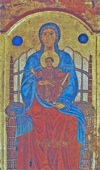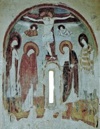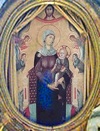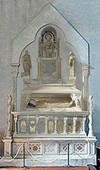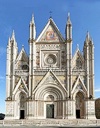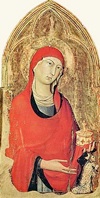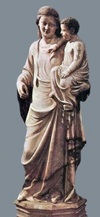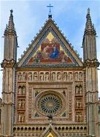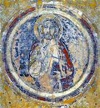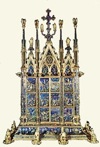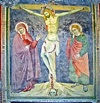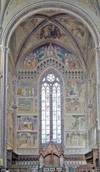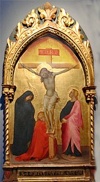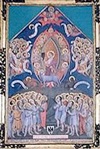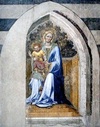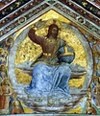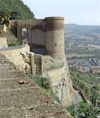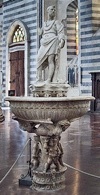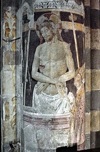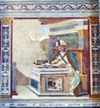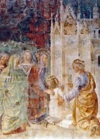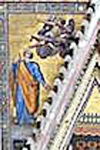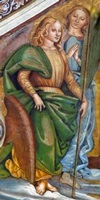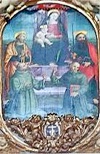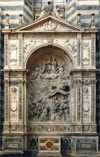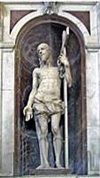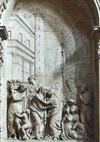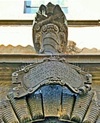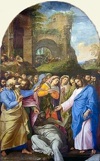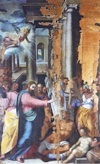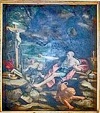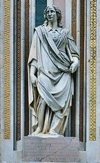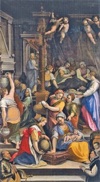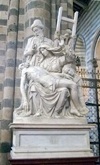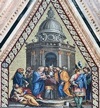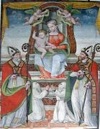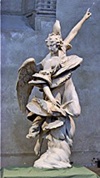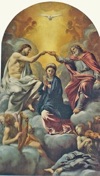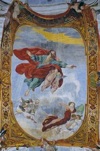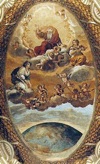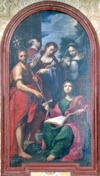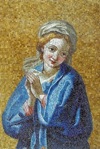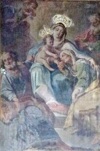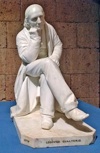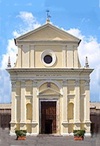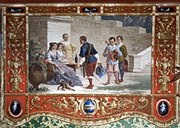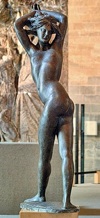

Simone and Machilone (died after 1258)
These artists are known from three signed works. This icon (13th century) from Santa Maria del Carmine, which is now in the Museo dell’ Opera del Duomo, is attributed to them. A painted crucifix in the museum that came from San Ludovico is less securely attributed to them or to their followers.
Maestro dei SS Severo e Martirio (13th century)
This unfinished fresco (13th century) of the Crucifixion with the Virgin and saints, which is the autograph work of this master, is in the apse of the upper church of the Abbazia dei SS Severo e Martirio. It depicts the Crucifixion with the Virgin and SS Mary Magdalene, John the Evangelist and John the Baptist. Other frescoes in San Giovenale are attributed to him.
Maestro della Madonna di San Brizio (late 13th century)
This master is named for a panel (late 13th century) known as the Madonna di San Brizio, which is now in the Cappella Nuova of the Duomo. A number of other works in Orvieto are attributed to him.
Arnolfo di Cambio (died 1302)
Arnolfo di Cambio was probably the leading artist of his day. He is first documented in Rome in 1277, in the employment of King Charles d’ Anjou. His first signed work was the monument (ca. 1282) to Cardinal Guillaume de Braye in San Domenico, Orvieto (illustrated here).
Fra Bevignate (died after 1306)
Probably from Cingoli, based in Perugia
Fra Bevignate was Director of Works in Perugia for some 30 years until his death. He is documented in Orvieto in 1291, probably to initiate the construction of the Duomo (1291-1300). He had certainly acted as "operarius” (probably overall supervisor) on the project before 1295, the year in which he was reconfirmed in this post, and another confirmation followed in 1300. He seems to have been responsible for the initial design, the construction of the nave and the bottom order of the facade.
[Temporary link to Fra. Bevignate]
Rubeus (late 13th/ early 14th century)
The bronze architrave (late 13th century) of the Porta di Postierla of the Duomo, which depicts Christ and the Apostles, was signed by a man called Rubeus. He was probably the same artist commemorated on the bronze upper basin (1277) of the Fontana Maggiore, Perugia. He probably worked under Ramo di Paganello (below) in ca. 1302-10, when the latter seems to have been capomaestro at the Duomo, Orvieto.
Ramo di Paganello (died after 1315)
Ramo di Paganello was documented in his native city in 1281, when he returned from exile in France. No signed or securely documented examples of his work are known. He seems to have been capomaestro at the Duomo, Orvieto in ca. 1302-10, and subsequently to have worked at the Angevin court of Naples. The sculpture of the Porta di Postierla of the Duomo (illustrated here) and the reliefs on the capitals of four columns in the nave are attributed to him.
Lorenzo Maitani (died 1330)
Lorenzo Maitani spent the last two decades of his life working on the Duomo of Orvieto, and its facade is his most important surviving work.
Simone Martini (ca. 1284-1344)
Simone Martini painted important polyptychs for churches in Orvieto:
-
✴the San Domenico Polyptych (ca. 1321), which includes the panel of St Mary Magdalene illustrated here;
-
✴the San Francesco Polyptych (ca. 1325); and
-
✴the so-called Gardner Polyptych (1320s), for Santa Maria dei Servi.
Giovanni di Bonino (died after 1345)
All of the surviving documents relating to “Maestro Giovanni di Bonino di Assisi” relate to work carried out in the Duomo of Orvieto. One of these documents relates specifically to the surviving stained glass window (1334) in the tribune.
Andrea Pisano (died ca. 1348) and Nino Pisano (died ca. 1368)
Andrea Pisano sculpted the reliefs (1330) on the bronze south doors of the Baptistery, Florence. He was capomaestro at the Duomo Orvieto in 1347-8, and was succeeded by his son, Nino Pisano, in 1349-50. He executed this figure (1347) for the Duomo, Orvieto in Pisa. One of the two angels that were associated with it is attributed to Nino Pisano, as is a figure of Christ. All of these figures are now in the Museo dell’ Opera del Duomo, Orvieto.
Andrea Orcagna (died 1368)
From Florence
Giovanni di Buccio di Leonardello (died after 1370)
Giovanni di Buccio di Leonardello was involved in the mosaic decoration of the facade of the Duomo in 1360-6. The damaged frescoes in tondi in the vaults of the Cappella di San Sabino of San Giovenale (including this one of Christ the Redeemer) are attributed to him.
Ugolino di Vieri (died ca. 1380)
The goldsmith Ugolino di Vieri is best known for the Reliquary of the Sacro Corporale (1337-8) in the Cappella del Corporale of the Duomo, Orvieto (illustrated here). He also si the Reliquary of St Sabinus (ca. 1340) for San Giovenale, Orvieto, which is now in the Museo dell’ Opera del Duomo.
Ugolino di Montemarte (1325-88)
Ugolino di Petruccio da Corbara, Conte di Montemarte, entered the service of Cardinal Gil Albornoz in 1353 and remained in papal service for the rest of his life. He was primarily a soldier and administrator, but he also became expert in military fortifications. A document (1364) in the archives of Orvieto records that he supervised the construction of the Rocca dell’ Albornoz. It was demolished in the 15th century, but traces survive.
Pietro di Puccio (died after 1394)
Pietro di Puccio is documented at the Duomo on several occasions in 1360-88. For example, he designed the original mosaics (1388) of the Doctors of the Church that surrounded the rose window (the later replacements of which are illustrated here), two of which survive in the Museo dell’ Opera del Duomo. Frescoes in the Cappella di San Matteo of San Francesco and in San Giovenale are attributed to him. His last known works were the frescoes (1389-91) of scenes from Genesis at the Camposanto, Pisa, which were destroyed in the bombardment of the Second World War.
Cola Petruccioli (died 1401)
Cola Petruccioli was documented in 1372-8, as a young apprentice working for Ugolino di Prete Ilario (below) in the choir of the Duomo. His earliest surviving signed work is a fresco (1380) of the Crucifixion (illustrated here) in the crypt of the Duomo. He was also documented in 1380, with Francesco di Antonio and Andrea di Giovanni (below), in relation to the frescoes of a fictive choir in the tribune of the Duomo. A fresco (ca. 1380) of the Annunciation in San Giovenale is attributed to Cola Petruccioli and Andrea di Giovanni.
Ugolino di Prete Ilario (died after 1403)
Ugolino di Prete Ilario was called to Orvieto from his native Siena in 1357 and is documented in the Duomo there until 1384. He played an important part in training local artists. His most important surviving work in the city is the fresco cycle of the Life of the Virgin (1370-84) in the tribune of the Duomo (illustrated here).
Spinello Aretino (died 1410)
Spinello Aretino was an important artist who worked mostly in Tuscany. This small panel (ca. 1400) of the dead Christ on the cross with the Virgin and SS John the Evangelist and Mary Magdalen, which came from Palazzo Comunale and which is now in the Museo dell’ Opera del Duomo, is attributed to him.
Andrea di Giovanni (died after 1424)
Probably from Orvieto
Gentile da Fabriano (died 1427)
From Fabriano
Bartolomeo da Miranda (died after 1449)
From Miranda, near Terni; moved to Spoleto
A triptych (15th century) attributed to Bartolomeo da Miranda, which originally belonged to the Confraternita di San Michele Arcangelo, was later in Palazzo Vescovile before it entered the Museo dell’ Opera del Duomo. The central panel depicts a half-length Madonna and Child on a gold background: the baby Jesus holds an apple and points to it with His other hand. The saints on the inner surfaces of the closing doors were over-painted in the 17th century with images of two Servite friars.
[Temporary link to Bartlomeo da Miranda]
Fra Angelico (1387–1455)
Fra Angelico to begin the frescoes (1447) of the Cappella Nuova of the Duomo, but was soon called away to Rome. He completed only two vanes of one of the the vaults, depicting: Christ in Judgment (illustrated here); and the Prophets. In 1499, Luca Signorelli (below) painted the other two vanes of this vault using Fra Angelico’s drawings, and then went on to complete the decoration of the chapel.
Bernardo Rossellino (1409-64)
Bernardo Rossellino, trained as an architect and sculptor in Florence in the 1420s. He was papal architect to Pope Nicholas V (1447-55): according to Giorgio Vasari. he worked on the fortress of Orvieto (and those of Narni and Spoleto) in this capacity in 1449.
Antonio Federighi (died 1483)
Antonio Federighi served as capomaestro of the cathedral workshop in his native Siena for three decades (1450-81). He held the same post at Orvieto in 1451-6. He held the same post at Orvieto in 1451-6. He was probably responsible for:
-
✴introducing the row of niches for twelve statues of the apostles above the rose window in the facade of the Duomo in order to correct its proportions;
-
✴sculpting the water stoup inside the Duomo (illustrated here); and
-
✴executing the figure (1456) of the Eritrean Sibyl on the facade.
Giovanni Boccati (died after 1486)
From Camerino, moved to Perugia
The St Sabinus Altarpiece (1473) by Giovanni Boccati came from the Cappella di San Sabino of the Duomo:
-
✴its main panel, which depicts the Madonna and Child with SS Juvenal, Sabinus, Augustine and Jerome, is now in Szpmvszeti Muzeum (Museum of Fine Arts), Budapest; and
-
✴its four predella panels of scenes from the life of St Sabinus are in other locations.
[Temporary link to Giovanni Boccati ]
Pietro di Nicola Baroni (died after 1489)
Pietro di Nicola Baroni was one of the most prolific painters in Orvieto in the 15th century. He worked under Fra Angelico on the frescoes of the Cappella Nuova of the Duomo in 1447-9. He also painted this fresco (1468) in the the Cappellina dei Corpi Santi, on the right wall of the Cappella Nuova. The fresco, which originally depicted the Pietà with SS Faustinus and Peter Parenzo, has been detached and is now in the Museo dell’ Opera del Duomo.
Benozzo Gozzoli (1420-97)
From Florence
Benozzo Gozzoli worked with Fra Angelico on the frescoes (1447) on the ceiling of the Cappella Nuova of the Duomo, but he failed to secure the job of continuing the decoration of the chapel. Two other lost works from the Duomo are known:
-
✴A cartoon that Benozzo made for a stained glass window was documented in 1448, but neither the drawing nor the window survive.
-
✴In 1449, Benozzo finished an Annunciation for a lady called Gianna Gregori, but she no longer wanted it. Benozzo therefore donated it to the Opera del Duomo.
Neither work was deemed good enough to win for him the commission to succeed Fra Angelico in the Cappella Nuova.
[Temporary link to Benozzo Gozzoli]
Pier Matteo d' Amelia (ca. 1445-1509)
The panels from the important polyptych (1481) by Pier Matteo d' Amelia from Sant’ Agostino are now sadly dispersed. A fresco (ca. 1482) in the Duomo, which depicts Pietà and St Gregory (illustrated here), is attributed to him.
Bernardino di Betto, Pintoricchio (ca. 1454–1513)
The frescoes (1370-84) in the apse of the Duomo by Ugolino di Prete Ilario, which depict of scenes from the life of the Virgin were restored for the first time in 1492-7. As part of this programme, Pintoricchio repainted four frescoes on the right wall, two of which survive:
-
✴St Mark writing his Gospel; and
-
✴St Ambrose in his study (illustrated here).
Antonio da Viterbo, il Pastura (died 1516)
From Viterbo
Jacopo Ripanda (died after 1516)
Jacopo Ripanda was first documented at work on the Duomo, Orvieto in 1485-95, in connection with the mosaics of the facade and the restoration of the frescoes in the tribune. He executed the mosaic (1487-92) of the annunciation to St Joachim in the gable over the right door (illustrated here). The St Juvenal Altarpiece (ca. 1490) from San Giovenale, which is now the Museo dell' Opera del Duomo, is attributed to him and to his associates. He spent the rest of his career in Rome.
Luca Signorelli (died 1523)
The frescoes in the Cappella Nuova of the Duomo, are Signorelli’s masterpieces. They include:
-
✴frescoes (1499) in the two vanes in the vault nearest the altar, which were completed using Fra Angelico’s drawings and depict:
-
•angels with the instruments of the Passion; and
-
•the Virgin and the Apostles
-
✴frescoes (1499-1500) of the entrance vault, which depict four categories of saints:
-
•virgins;
-
•patriarchs;
-
•martyrs; and
-
•confessors; and
-
✴the famous cycle of frescoes (1500-4) depicting scenes from the Last Judgement, which include the self-portrait illustrated here (with a portrait of Fra Angelico to the right).
An altarpiece (1504) by Signorelli depicting St Mary Magdalene was removed from the Cappella Nuova in 1653 and is now in the Museo del Opera dell’ Duomo.
Pietro Vannucci, il Perugino (1446–1524)
Perugino signed a contract to complete the frescoes of the Cappella Nuova of the Duomo in 1489. He is documented at work for a short period in 1491, but never subsequently returned to Orvieto. While the scene of the Angels with instruments of the Passion in the the vault nearest the altar is attributed to Luca Signorelli, the design of two of the angels (illustrated here) and perhaps their execution are sometimes attributed to Perugino.
Cristoforo da Marsciano (died after 1534)
From Marsciano, near Orvieto
This artist is documented in Orvieto from 1499. The damaged frescoes in the apse of San Rocco are reasonably securely attributed to him.
[Temporary link to Cristoforo da Marsciano]
Antonio da Sangallo il Giovane (1484-1546)
From Florence, based in Rome
Sinibaldo Ibi (died after 1548)
Sinbaldo Ibi belonged to the so-called workshop of 1496 in Perugia. This altarpiece (mid 16th century) on the high altar of San Bernardino is attributed to him. It depicts the Madonna and Child with SS Peter, Paul, Francis and Bernardino of Siena.
Simone Mosca (1492–1553)
Simone Mosca began his association with Orvieto in 1535 and became capomaestro of the Duomo there three years later. He remained in the city until his death. Among his many works there, he supervised the construction and decoration of the Cappella dei Magi (1535-46, illustrated here) in the right transept of the Duomo, and of its pendant Cappella della Visitazione (1547-54).
Michele Sanmicheli (1484-1559)
Michele Sanmicheli, who came from Verona, was capomaestro of the Duomo of Orvieto in 1509-25. He also worked in the city for the Petrucci family: the relief illustrated here is from Tomba Petrucci (1516-24), which is in the family’s subterranean chapel in San Domenico.
Raffaello da Montelupo (1504-66)
Raffaello da Montelupo survived the sack of Rome in 1527 and went on to work there under Michelangelo. He moved to Orvieto in 1552, and sent the last 15 years of his life as capomaestro at the Duomo. This statue (ca. 1550) of the Risen Christ, which survives in the Duomo, is attributed to him: was probably inspired by the similar statue (1518-20) by Michelangelo in Santa Maria sopra Minerva, Rome.
Francesco Mosca, il Moschino (died 1578)
Francesco started work at an early age, working under his father, Simone Mosca (above) on the Duomo of Orvieto. His finest work there was the central relief (1547-54) on the Cappella dell Visitazione, illustrated here. He left Orvieto for Florence after his father’s death in 1553.
Ludovico Scalza (died after 1578)
From Orvieto
Girolamo Muziano (died 1592)
Girolamo Muziano contributed four altarpieces to a series depicting scenes from the life of Christ for the Duomo of Orvieto. These were removed in 1890 and are now in the Museo dell’ Opera del Duomo. They included the Raising of Lazarus, illustrated here.
Giovanni Battista Lombardelli (died 1592)
From Montenovo (now called Ostra Vetere) in the March of Ancona
This important artist executed a number of commissions in Perugia, including his last documented works in San Pietro there. He seems to have worked with Cesare Nebbia (below) in ca. 1585 on the frescoes of Palazzo Buzi.
[Temporary link to Giovanni Battista Lombardelli]
Nicolò Circignani, il Pomarancio (died 1596)
From Pomarance, near Volterra, based in Rome
Arrigo Fiammingo (1519-97)
Arrigo Fiammingo da Malines (Hendrik van den Broeck, Heinrich Paludanus) was one of very few Flemish artists who established careers in Italy in the 16th century. This altarpiece (1580) of St Jerome in San Francesco is dated by inscription and signed “VB”: some scholars therefore attribute it to Arrigo Fiammingo (who signed a fresco (ca. 1572) in the Sistine Chapel “HVDB”).
Fabiano Toti (died 1607)
Fabiano Toti, who was born in Orvieto, was a pupil of Ippolito Scalza (see below), under whom he worked at the Duomo. A number of his full-length sculpted figures survive in the Duomo, including this figure (1588) of the Libyan Sibyl on the facade. Other figures by Fabiano Toti are now exhibited in the ex-church of Sant’ Agostino.
Federico Zuccari (died 1609)
From near Urbino, based in Rome
Two altarpieces (1568-71) by Federico Zuccari, which depict miracles of Christ, were commissioned for altars in the nave of the Duomo and are now in the Museo dell’ Opera del Duomo.
[Temporary link to Taddeo and Federico Zuccari]
Cesare Nebbia (died 1614)
Cesare Nebbia probably worked under Girolamo Muziano in the Duomo in 1555-8. He established his independent career there from 1566. Much of his work there was destroyed in 1890, but four altarpieces by him survive in the Museo dell’ Opera del Duomo. These include this altarpiece (1582) of the Birth of the Virgin. Nebbia also established a reputation in Rome, particularly under Pope Sixtus V (1585-90).
Ippolito Scalza (1532-1617)
From Orvieto
Antonio Circignani, il Pomarancio (1570-1630)
Antonio Circignani designed the cartoon (1612) for this mosaic of the Marriage of the Virgin on the facade of the Duomo.
Pietro Paolo Sensini (1555-1632)
From Todi
-
✴an altarpiece (late 16th century) of the Madonna and Child with SS Pius V and Peter Martyr in the Museo dell’ Opera del Duomo, which may have come from San Domenico; and
-
✴an altarpiece (17th century) of the Madonna and Child with SS Juvenal and Sabinus and two hooded penitents in San Giovenale (illustrated here).
Francesco Mochi (1580-1654)
Duke Mario Farnese secured Francesco Mochi’s first major commission, which was for the two figures of the Annunciation (1605-8) in the Duomo of Orvieto. Mochi subsequently executed two bronze equestrian statues in Piacenza, of Rannuccio Farnese (1612–20) and Alessandro Farnese (1620–29), followed by an important figure (1629-40) of St Veronica, in St Peter’s, Rome. His other works for the Duomo of Orvieto were figures of St Philip (1609-10) and St Thaddeus (1638-44). All four figures are now exhibited in the ex-church of Sant’ Agostino.
Giovanni Lanfranco (1582-1647)
Giovanni Lanfranco was among the most important artists working in Rome for almost two decades until 1631, the year in which he became the Principal of the Academy of St Luke. He subsequently moved to Naples but returned to Rome shortly before his death. His altarpiece (1616) of the Coronation of the Virgin from Santa Maria del Carmine in Orvieto is now in the Museo dell' Opera del Duomo.
Giovanni Maria Colombi (died after 1658)
Giovanni Maria Colombi was documented in Rome in 1637-8, but subsequently worked primarily in Orvieto. Works signed by him survive in the Chiesa del Buon Gesù and San Paolo (dated respectively to 1637 and 1647). The latter include this fresco in the vault, which depicts St Paul approaching the third heaven.
Salvi Castellucci (1608-1672)
Salvi Castellucci trained in Rome under Pietro da Cortona. A number of frescoes in Orvieto are by or attributed to him, including this documented fresco (1664) of God the Father in the vaults of the Oratorio della Misericordia.
Giacinto Gimignani (1606-81)
From Pistoia
Giacinto Gimignani was documented in Rome from 1630 as an associate of Pietro da Cortona. An altarpiece (ca. 1650) in San Bernardino is attributed to him.
[Temporary link to Giacinto Gimignani]
Domenico Maria Muratori (1661-1742)
Cardinal Filippo Antonio Gualterio commissioned this panel for the Altare dei SS Giovanni Battista e Agnese, a new altar that he erected in the Cappella Nuova of the Duomo. It is attributed to Domenico Maria Muratori and was probably executed in Rome. It depicts St John the Evangelist writing his gospel, with SS John the Baptist, Mary Magdalene, St Agnes (with a lamb) and Charles Borromeo.
Ludovico Mazzanti (1686–1775)
Ludovico Mazzanti had close links with Orvieto, his father’s native city. He trained in Rome and spent most of his career there. His works in Orvieto were mainly carried out in 1713-4. These included a new mosaic of the Coronation of the Virgin on the facade of the Duomo, a fragment of which (illustrated here) survives in the Museo dell’ opera del Duomo.
Filippo Naldini (died 1782)
Probably born in Orvieto
Giovanni Dupré (1817-82)
Giovanni Dupré was a leading sculptor of the Risorgimento. He signed this portrait (1853) of Ludovico Gualterio, which in the Museo dell’ Opera del Duomo.
Virginio Vespignani (1808-82)
From Siena
Mariano Piervittori (1815-88)
From Tolentino, moved to Foligno as a child
[Text] His work in Orvieto includes frescoes (ca. 1880) in Palazzo Buzi, including this one in which a noble man pays his respects to two ladies.
Emilio Greco (1913-95)
Emilio Greco moved to Rome in 1943 and was Professor of Sculpture at the Liceo Artistico there in 1948-52. Among his last works was the monument (1965–6) to Pope John XXIII in St Peter's, Rome. His association with Orvieto began with the bronze doors (1962-4) that he executed for the Duomo. The collection of works that he donated to the city in 1991, which included the nude illustrated here, formed the basis for the Museo Emilio Greco in Palazzo Soliano.
